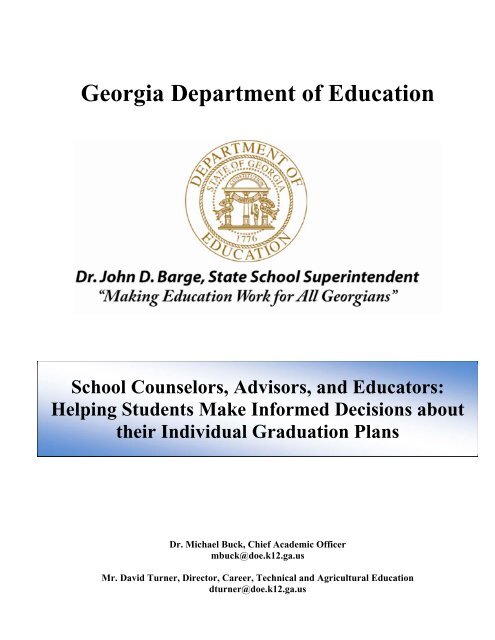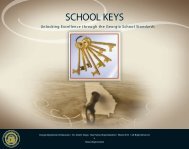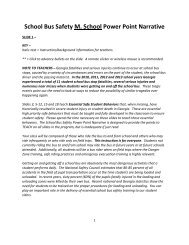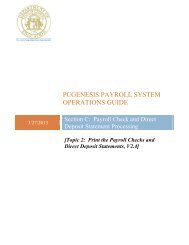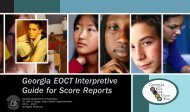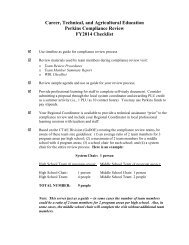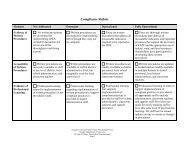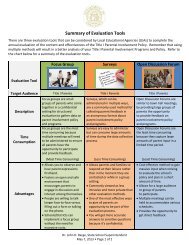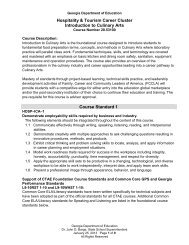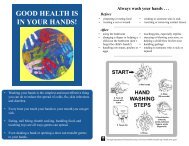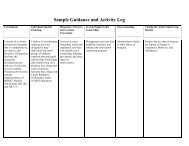Individual Graduation Plan Activities and Advisement - Georgia ...
Individual Graduation Plan Activities and Advisement - Georgia ...
Individual Graduation Plan Activities and Advisement - Georgia ...
- No tags were found...
You also want an ePaper? Increase the reach of your titles
YUMPU automatically turns print PDFs into web optimized ePapers that Google loves.
<strong>Georgia</strong> Department of EducationSchool Counselors, Advisors, <strong>and</strong> Educators:Helping Students Make Informed Decisions abouttheir <strong>Individual</strong> <strong>Graduation</strong> <strong>Plan</strong>sDr. Michael Buck, Chief Academic Officermbuck@doe.k12.ga.usMr. David Turner, Director, Career, Technical <strong>and</strong> Agricultural Educationdturner@doe.k12.ga.us
<strong>Georgia</strong> Department of EducationSchool Counselors, Advisors, <strong>and</strong> Educators:Helping Students Make Informed Decisions abouttheir <strong>Individual</strong> <strong>Graduation</strong> <strong>Plan</strong>sDr. Michael Buck, Chief Academic Officermbuck@doe.k12.ga.usMr. David Turner, Director, Career, Technical <strong>and</strong> Agricultural Educationdturner@doe.k12.ga.us
Introduction:Education <strong>and</strong> career planning is a vital part of a student’s educational career. The ability ofstudents to connect their education <strong>and</strong> training to their future career is vital to theirproductiveness as a citizen in our society <strong>and</strong> to their future employability. The ability tomatch education alternatives with career options is critically important for a student’sunderst<strong>and</strong>ing of how choices made as a teenager can affect an entire lifetime. It is a processin which an individual defines <strong>and</strong> re-defines career-related choices <strong>and</strong> outcomes. This guideprovides “Read, Teach, <strong>and</strong> Discover” lesson plans to aid students in Career <strong>Plan</strong>ning, HighSchool <strong>Plan</strong>ning, College <strong>Plan</strong>ning, Financial Aid <strong>Plan</strong>ning <strong>and</strong> development of a managedPortfolio which will result in better <strong>and</strong> more informed decision making about the world ofwork <strong>and</strong> needed educational opportunities.One vital key for helping students in making postsecondary decisions is an underst<strong>and</strong>ing thatcollege is only one piece of the postsecondary education <strong>and</strong> training puzzle. In fact, colleges<strong>and</strong> universities represent approximately 35% of the entire system available for postsecondaryeducation <strong>and</strong> training. Other options, include, military training, apprenticeships, on-the-jobtraining, employer provided training, <strong>and</strong> specialty schools. Of course, the role of colleges <strong>and</strong>universities cannot be underestimated as they provide a gateway to other postsecondaryprograms, immediate entry into the workforce, <strong>and</strong> enhanced salary options. College graduatesare almost twice as likely as high school graduates to have opportunities for enhancedmonetary gain due to opportunities for on the job specialty training <strong>and</strong> access to technology.In a recent study, Georgetown University provides some interesting data. Since 1983, amongprime-age workers between the ages of 25 <strong>and</strong> 54:• Earnings of high school dropouts have fallen by 2 percent;• Earnings of high school graduates have increased by 13 percent;• Earnings of people with some college or an Associate’s degree have increased by 15 percent;• Earnings of people with Bachelor’s degrees have increased by 34 percent;• Earnings of people with graduate degrees have increased by 55 percent.This clearly delineates the hierarchical relationship between formal education level <strong>and</strong> yearlywages. It also reflects the compensation that employers are willing to pay for the knowledge,skills, <strong>and</strong> abilities workers attain at each increased education level.(Help Wanted. Projections of Jobs <strong>and</strong> Education Requirements through 2018, The Georgetown UniversityCenter on Education <strong>and</strong> the Workforce, June 2010).With these underst<strong>and</strong>ings, the <strong>Georgia</strong> state legislature creates an obligation for schoolsystems to provide students <strong>and</strong> their parents with career-related information in a systematic<strong>and</strong> developmental process. This guide was developed to assist local systems in the applicationof tools, resources, <strong>and</strong> materials developed with federal grant funds from the College AccessChallenge Grant to assist all students, including underrepresented students, in the education<strong>and</strong> career planning process utilizing the enhanced GAcollege411 website atwww.gacollege411.org.Dr. John Barge, State School SuperintendentJune 4, 2012 All Rights Reserved2
Table of ContentsIntroduction Page 2Table of Contents Page 3State Board Student <strong>Advisement</strong> Rule <strong>and</strong> Terms Page 4-6Overview for 6 th grade advisement activities Page 76 th Suggested Activity <strong>Plan</strong> using www.GAcollege411.org Page 8Overview for 7 th grade advisement activities Page 97 th Suggested Activity <strong>Plan</strong> using www.GAcollege411.org Page 10Overview for 8 th grade advisement activities Page 118 th Suggested Activity <strong>Plan</strong> using www.GAcollege411.org Page 12Creating the High School <strong>Graduation</strong> <strong>Plan</strong> of Study Pages 13-14Overview for 9 th grade advisement activities Page 159 th Suggested Activity <strong>Plan</strong> using www.GAcollege411.org Page 16Overview for 10 th grade advisement activities Page 1710 th Suggested Activity <strong>Plan</strong> using www.GAcollege411.org Page 18Overview for 11 th grade advisement activities Page 1911 th Suggested Activity <strong>Plan</strong> using www.GAcollege411.org Page 20Overview for 12 th grade advisement activities Page 2112 th Suggested Activity <strong>Plan</strong> using www.GAcollege411.org Page 22The <strong>Georgia</strong> Department of Education (GaDOE) does not discriminate on the basis of race, color, religion, sex,national origin, age, or disability in its programs, activities, or employment practices.This document was developed using funds from the US Department of Education College Access ChallengeGrant. However, this document does not necessarily represent their policies, <strong>and</strong> you should not assumeendorsement by the Federal Government.Dr. John Barge, State School SuperintendentJune 4, 2012 All Rights Reserved3
160-4-8-.09 STUDENT ADVISEMENT.Code: JEA/IGA(1) DEFINITIONS.(a) Apprenticeship – a structured program that connects school-based occupationalinstruction <strong>and</strong> related paid work-site experiences in order to prepare students for the world ofwork. Students are able to receive a high school diploma, a postsecondary certificate, or degreeor industry certification.(b) Articulation – an agreement between a high school <strong>and</strong> a postsecondary institutionregarding the awarding of both secondary <strong>and</strong> postsecondary credit for a dual enrollmentcourse.(c) Cooperative education – structured student learning in a paid work position whileconcurrently enrolled in a related Career, Technical <strong>and</strong> Agriculture Education class, whichconnects career interests to academic <strong>and</strong> occupational learning in cooperation with business<strong>and</strong> industry.(d) Dual enrollment – a program through which high school students take courses from aneligible state public or private postsecondary institution while still enrolled as a high schoolstudent <strong>and</strong> receive credit both at the high school <strong>and</strong> at the postsecondary institution.(f) <strong>Individual</strong>ized education program (IEP) – a written statement for each child with adisability that states the present level of academic achievement <strong>and</strong> functional performance.The IEP is developed, reviewed, <strong>and</strong> revised in accordance with the <strong>Individual</strong>s withDisabilities Education Act, as amended.(g) <strong>Individual</strong> graduation plan – a student specific plan developed detailing the coursesnecessary for a high school student to graduate from high school <strong>and</strong> to successfully transitionto postsecondary education <strong>and</strong> the work force.(h) Internship – a structured placement, either short term or long term, which enables astudent to connect career interests to academic <strong>and</strong> occupational learning in cooperation withbusiness <strong>and</strong> industry in a paid or non paid position.(i) Joint enrollment – an arrangement whereby a high school student is enrolled in apostsecondary institution while continuing to pursue his or her high school diploma. Jointenrollment coursework earns postsecondary credit only.(j) Local education agency – a local school system pursuant to local board of educationcontrol <strong>and</strong> management.Dr. John Barge, State School SuperintendentJune 4, 2012 All Rights Reserved4
(k) Mentoring – support <strong>and</strong> guidance provided to students through relationships with adultswho advise <strong>and</strong> act as role models for students.(l) Service learning – a teaching method in which guided or classroom learning is deepenedthrough service to others in a process that provides structured time for reflection on the serviceexperience <strong>and</strong> demonstration of the skills <strong>and</strong> knowledge acquired.(m) Teacher as advisor – a teacher or professional educator in the school who assists asmall group of students <strong>and</strong> their parents or guardians to set postsecondary goals <strong>and</strong> helpthem prepare programs of study, track academic progress <strong>and</strong> provide advisement <strong>and</strong> supportas needed.(2) REQUIREMENTS.(a) Each local education agency (LEA) shall provide students in the sixth, seventh, <strong>and</strong>eighth grades counseling, advisement, career exploration, career interest inventories, <strong>and</strong>information to assist them evaluating academic skills <strong>and</strong> career interests.(b) Each LEA shall ensure that each student develops an individual graduation plan beforethe end of the second semester of the eighth grade. The individual graduation plan shall bedeveloped in consultation with the student’s parents, guardians, or individuals appointed bythe student’s parents or guardians to serve as their designee.(c) Each LEA shall provide guidance, advisement, <strong>and</strong> counseling to each high schoolstudent that will enable the student to successfully complete his or her individual graduationplan <strong>and</strong> prepare him or her for a seamless transition to postsecondary study, further training,or employment.(d) Each student’s individual graduation plan shall:1. Include rigorous academic core subjects <strong>and</strong> focused course work in mathematics <strong>and</strong>science or in humanities, fine arts, <strong>and</strong> foreign language or sequenced career pathwaycoursework;2. Incorporate provisions of a student’s <strong>Individual</strong>ized Education Program (IEP), whereapplicable;3. Align educational <strong>and</strong> broad career goals <strong>and</strong> the student’s course of study;4. Be based on the student’s selected academic <strong>and</strong> career focus area as approved by thestudent’s parent or guardian;Dr. John Barge, State School SuperintendentJune 4, 2012 All Rights Reserved5
5. Include experience-based career oriented learning experiences, which may include butnot be limited to, internships, apprenticeships, mentoring, cooperative education, <strong>and</strong> servicelearning;6. Include opportunities for postsecondary studies through articulation, dual enrollment,<strong>and</strong> joint enrollment;7. Allow flexibility to change the course of study but remain sufficiently structured tomeet graduation requirements <strong>and</strong> qualify the student for admission to postsecondaryeducation;8. Be approved by the student <strong>and</strong> the student’s parent or guardian with guidance fromthe student’s school counselor or teacher advisor; <strong>and</strong>9. Be reviewed <strong>and</strong> revised, if appropriate, upon approval by the student <strong>and</strong> the student’sparent or guardian with guidance from the student’s school counselor or teacher advisor.(e) An individual graduation plan may be changed at any time throughout a student’s highschool career upon approval by the student <strong>and</strong> the student’s parent or guardian with guidancefrom the student’s school or teacher advisor.Authority: O.C.G.A. §20-2-131; 20-2-151(b); 20-2-281(b); 20-2-326; 20-2-327Adopted: July 21, 2011 Effective: August 11, 2011Dr. John Barge, State School SuperintendentJune 4, 2012 All Rights Reserved6
Meeting 6th Grade Student <strong>Advisement</strong> Requirements for State Board Rule 160-4-8-.096th GradeOverviewHelpful Information while using the Sample Activity <strong>Plan</strong> with www.GAcollege411.orgSample Answers to “Ideas to Jumpstart the <strong>Activities</strong>”1. GAcollege411.org is an interactive website designed to aid students in:a. Goal Settingb. Career <strong>Plan</strong>ningc. High School <strong>Plan</strong>ningd. College <strong>Plan</strong>ninge. Financial <strong>Plan</strong>ningf. Portfolio Managing2. GAcollege411.org allows the student to create a career portfolio in the 6 th grade. The portfolio will contain allinformation that the student needs to be successful in planning the future. The portfolio will contain stateidentified, interest inventories, career clusters <strong>and</strong> pathways of interest, preferred after high school plans,potential colleges <strong>and</strong> personal notes for future planning.3. Students will access the portfolio at least once per year with the advisor/counselor. Ideally, students willaccess the website on a regular basis to learn more about themselves, evaluate future goals <strong>and</strong> plans, <strong>and</strong>learn about their future career such as salary, education level required <strong>and</strong> personal skills required.4. Career clusters are groupings of occupations with common knowledge <strong>and</strong> skills for the purpose of organizingprograms <strong>and</strong> curricula. Each career cluster is divided into aligned pathways. For example, Agriculture is aCareer Cluster. Current career pathways within the agriculture cluster are Veterinary Science, Agribusiness,Small Animal Care, Horticulture <strong>and</strong> Agriscience. Sample occupations include veterinarian, farm manager,horticulturist, animal breeder, equine scientist, <strong>and</strong> l<strong>and</strong>scaper.Additional Helpful TipsWhen students access GAcollege411.org for the first time, having a pre‐advisement worksheet is helpful.The worksheet would provide username <strong>and</strong> password information. A school district would find ithelpful to predetermine uniform passwords <strong>and</strong> usernames as shown in the example below. Remindstudents to keep track of their login information <strong>and</strong> avoid creating additional accounts.Student name: Mark JacobsUsername: 178934markjPassword: XK2v3MpChange Password: 178934(Student ID number with First name <strong>and</strong> first initial of last name)(No spaces, special characters or capitalization)(generic password assigned by computer during “batching”)(student ID number)6th Grade OverviewDr. John Barge, State School SuperintendentJune 4, 2012 All Rights Reserved7
Meeting 6th Grade Student <strong>Advisement</strong> Requirements for State Board Rule 160-4-8-.09Requirements:1. Create an electronic account/portfolio2. Take a career assessment inventorySample Activity <strong>Plan</strong> using www.GAcollege411.orgIdeas to Jumpstart the <strong>Activities</strong> (see reverse side for more information)Ask your students:1. What is GAcollege 411?2. Why do I need to use Gacollege411?3. How often will I use this site?4. What is a career cluster?Meeting Requirement #1 (Time varies )1. Sign in to www.GAcollege411.org .2. Create a USERNAME <strong>and</strong> PASSWORD (Create generic usernames [first name, initial of last name, <strong>and</strong> student#] <strong>and</strong> generic passwords [student #] to aid advisors in helping students sign in to accounts each year.)3. Accounts can be “batch created” using instructions in the Professional Center under Create Student Accounts.Accounts can also be merged or released here. (For additional help or information, contact support@gacollege411.orgor call the Customer Contact Center at 1‐800‐505‐4732)Meeting Requirement #2 –Time required 45 minutes1. To take a career assessment, sign in to www.GAcollege411.org.2. Click on the Career <strong>Plan</strong>ning Tab at the top of the page.3. Click on Learn about Yourself.4. Click on Interest Profiler.5. Have students take inventory. It is automatically saved after each question is answered.6. Upon completion, have students read Your Top Interest Areas.7. Click View Careers <strong>and</strong> explore the various careers chosen for the student from the Interest Profiler.8. Explore the Education Level, Earnings, <strong>and</strong> Career Cluster shown.Connect to the Curriculum Using These Suggested <strong>Activities</strong>1. Enter the Professional Center under Middle <strong>and</strong> HighEducators on Home Page (must have or create an account)2. Click on Resources3. Click on Changing World, Changing Careers <strong>and</strong> follow lesson.4. Utilize the Teachers As Advisors scope <strong>and</strong> sequence forrelated activities.Data Information # of 6 th grade accounts/portfolioscreated/usage report # of 6 th grade students completing onecareer‐related assessment(CCRPI)/outcome report6th Grade RequirementsDr. John Barge, State School SuperintendentJune 4, 2012 All Rights Reserved8
Meeting 7th Grade Student <strong>Advisement</strong> Requirements for State Board Rule 160-4-8-.097th GradeOverviewHelpful Information while using the Sample Activity <strong>Plan</strong> with www.GAcollege411.orgHelpful knowledge to use with “Ideas to Jumpstart the <strong>Activities</strong>”1. Career Clusters are groupings of occupations. Those groupings are based on common knowledge <strong>and</strong>skills. Each career cluster is divided into different Career Pathways. For example, Agriculture is a CareerCluster. Examples of the career pathways within the agriculture cluster are Veterinary Science,Agribusiness, Small Animal Care, Horticulture <strong>and</strong> Agriscience.2. After students complete the Career Cluster Survey, the career clusters will be rank ordered for thestudent aligning with their interests according to the completed questions in the survey. Have studentsexplore the career clusters which best matched their interests. Have them choose three to save in theportfolio following the directions on the following page under Meeting Requirement #1.3. Once students have explored the career clusters, <strong>and</strong> select the three that most interest them, havethem choose the top three career pathways using the direction under Meeting Requirement #2. Havestudents save their results in the portfolio. After all students have completed the activity, have a groupdiscussion <strong>and</strong> allow students the opportunity to share with others the choices that they made forpotential future careers.4. Knowing which career pathway most interests students will help them create a High School <strong>Graduation</strong><strong>Plan</strong> of Study during the 8 th grade year in GAcollege411.org. The courses chosen for high school studyshould be closely aligned to the student’s chosen career pathway.Additional Helpful informationAs students become more comfortable with the GAcollege411.org website, encourage them to completeadditional personal assessments on their own. These assessments can be found under Learn AboutYourself after clicking on the Career <strong>Plan</strong>ning tab.In the Career <strong>Plan</strong>ning Tab, encourage students to review the interviews, <strong>and</strong> watch the videos to learnabout Career Clusters <strong>and</strong> skills <strong>and</strong> education required, job outlook, <strong>and</strong> potential salary. Furtherexploration of possible careers helps the student identify whether certain jobs might fit their uniquepersonality.7th Grade OverviewDr. John Barge, State School SuperintendentJune 4, 2012 All Rights Reserved9
Meeting 7th Grade Student <strong>Advisement</strong> Requirements for State Board Rule 160-4-8-.09Requirements:1. Complete <strong>and</strong> save in the portfolio results froma <strong>Georgia</strong> defined career assessment (College<strong>and</strong> Career Readiness Performance Index).2. Explore <strong>and</strong> save in the portfolio three careerconcentrations/clustersSample Activity <strong>Plan</strong> using www.GAcollege411.orgIdeas to Jumpstart the <strong>Activities</strong> (see the reverse side for more information)Ask your students:1. What are a career cluster <strong>and</strong> a career pathway?2. Which three concentrations/clusters most interest you <strong>and</strong> why?3. Which career pathways in those clusters most interest you <strong>and</strong> why?4. How does knowing about career pathways help you make decisions for high school <strong>and</strong> your future?Meeting Requirement #1‐‐‐Take <strong>and</strong> Save a Career Assessment/Interest Inventory –Time Required – 25 minutes1. Sign in to www.GAcollege411.org using your USERNAME <strong>and</strong> PASSWORD. REMIND students to NEVERcreate additional accounts.2. Click on the Career <strong>Plan</strong>ning tab.3. Click on the Learn About Yourself link.4. Click on the Career Cluster Survey.5. Explore the results of the survey. (Continue this activity under Meeting Requirement #2 below)Meeting Requirement #2‐‐‐ Explore <strong>and</strong> Save Three Career Clusters – Time Required – 25 minutes1. Using the results of your assessment:a. Explore Career Pathways in career clusters that interest you by clicking on the Cluster in the bar graph<strong>and</strong> then clicking on the Pathway.b. Using the tabs on the left, explore Careers in each pathway, Programs in each pathway <strong>and</strong>Recommended <strong>Plan</strong> of Study for each chosen pathway.2. While exploring three career clusters <strong>and</strong> career pathways, click on the Add to Portfolio tab for thepathways <strong>and</strong> clusters that are of interest.3. Continue to explore additional career clusters at leisure.Connect to the Curriculum Using These Suggested <strong>Activities</strong> Ask your students to write an essay about the top ranked careercluster or pathway <strong>and</strong> the suitability of it to the student’spersonality <strong>and</strong> interests. Utilize Teachers As Advisors Scope <strong>and</strong> Sequence in GAcollege411for related activities.Data Information # of 7 th grade students to complete <strong>and</strong>save a <strong>Georgia</strong> defined career‐relatedassessment (CCRPI/outcome report) # of 7 th grade students who have explored<strong>and</strong> saved three clusters to the portfolio(outcome report)7 th Grade RequirementsDr. John Barge, State School SuperintendentJune 4, 2012 All Rights Reserved10
Meeting 8th Grade Student <strong>Advisement</strong> Requirements for State Board Rule 160-4-8-.098th GradeOverviewHelpful Information while using the Sample Activity <strong>Plan</strong> with www.GAcollege411.org1. DefinitionsSample Answers to “Ideas to Jumpstart the <strong>Activities</strong>”a. Postsecondary Education ‐ Education beyond the secondary level, especially education at the college oruniversity level. Postsecondary education can also be obtained through the military, apprenticeships, <strong>and</strong>specialty schools.b. Technical Certificate of Credit – a certification of occupational training usually lasts a few weeks <strong>and</strong> thatshows training <strong>and</strong> proficiency has been completed.c. Associates Degree – a two year degree granted by a two year college to someone who has successfullycompleted the two year curriculum.d. Bachelors Degree ‐ an academic degree given to someone who has successfully completed a collegecurriculum, which generally requires four‐five years.e. Masters Degree ‐ An academic degree given by a college or university to someone who has completed atleast one year of prescribed study beyond the bachelor's degree.f. Specialist Degree – An academic degree awarded for study beyond the Bachelor’s degree to learn more indepth about a certain specialty.g. Professional Degree ‐ A professional degree prepares the holder for a particular career or profession suchas law, medicine, logistics, optometry, pharmacy, architecture, accounting, engineering, religious ministry,or education.2. Choosing a career that matches one’s interests <strong>and</strong> skills is important as most of one’s life will be spent on thejob. A minimum of 8 hours per day <strong>and</strong> 40 hours per week is the typical American work week.3. The average median salary for <strong>Georgia</strong> is $49,347 annually. Low income in <strong>Georgia</strong> is considered anyone makingless than $15,600 annually for one person. How does this knowledge affect a career choice? Use thisinformation to discuss #6 under Meeting Requirement #1 on the following page.Additional Helpful TipsUse the form entitled Creating the High School <strong>Graduation</strong> <strong>Plan</strong> of Study on the following pages, which is a stepby step guide to aid advisors in helping students complete their graduation plans. Remember the <strong>Individual</strong><strong>Graduation</strong> <strong>Plan</strong> represents a student’s PLAN based on self‐awareness <strong>and</strong> educational <strong>and</strong> career exploration,<strong>and</strong> is not a secondary schedule. The secondary school should make every attempt to assist students with theirfuture planning to include all possible options to reach their education <strong>and</strong> career goals. In an effort to minimizelimitations on the student’s effort to explore their options, the entire course catalog should be available forstudent course selections.8th Grade OverviewDr. John Barge, State School SuperintendentJune 4, 2012 All Rights Reserved11
Meeting 8th Grade Student <strong>Advisement</strong> Requirements for State Board Rule 160-4-8-.09Requirements:1. Explore <strong>and</strong> save three careers in the portfolio.2. Complete an individual graduation plan, approved <strong>and</strong> locked bythe counselor <strong>and</strong> approved by the parent/guardian to be used inthe transitional conference from middle to high school.3. Receive College Credit Now/Dual Enrollment information by April 1.Sample Activity <strong>Plan</strong> using www.GAcollege411.orgIdeas to Jumpstart the <strong>Activities</strong> (see reverse side for more information)Ask your students:1. What do the terms postsecondary education, technical certificate of credit, associates degree, bachelorsdegree, masters degree, <strong>and</strong> professional degree mean?2. Why should you choose a career that matches your interests <strong>and</strong> skills?3. What is the average or median salary for <strong>Georgia</strong> residents?Meeting Requirement #1‐ Time Required 45 minutes1. Sign in to www.GAcollege411.org using your USERNAME <strong>and</strong> PASSWORD.2. Click on the Career <strong>Plan</strong>ning tab.3. Click on the Learn About Yourself link.4. Click on The Career Key5. Using the results of The Career Key, <strong>and</strong> after reading Your Top Interest Areas, click on View Careers.6. Click on a minimum of three careers, <strong>and</strong> using the tabs on the left, explore What They Do, Skills You Need<strong>and</strong> Money <strong>and</strong> Outlook.7. Save three careers of interest in the portfolio.Meeting Requirement #2‐ Time Required 90 minutes1. Sign in to www.GAcollege411.org using your USERNAME <strong>and</strong> PASSWORD.2. Choose the High School <strong>Plan</strong>ning tab at the top of the screen.3. Click on Your <strong>Plan</strong> of Study.4. Click on Create Your Course <strong>Plan</strong>.5. Choose Program of Study (see all Career Clusters in blue). Click on the Career Cluster.6. Choose <strong>and</strong> Click on a Career Pathway (in blue).7. Click on Build your <strong>Plan</strong> with this Program of Study.8. Click Continue on the right <strong>and</strong> scroll down to see courses listed by grade <strong>and</strong> area.9. Follow directions on the next page entitled Creating the High School <strong>Graduation</strong> <strong>Plan</strong> of Study.Connect to the Curriculum Using This Suggested Activity1. Use the Real Life <strong>Activities</strong> on the tab to the left ofeach career chosen by the student to determine if thejob fits the student’s skills.2. Utilize Teachers As Advisors scope <strong>and</strong> sequenceactivities on the GAcollege411 web site.Data Information# of 8 th grade students who have saved threeoccupations in their portfolio (Outcome Report)# of completed, locked <strong>and</strong> parent approved <strong>Individual</strong><strong>Graduation</strong> <strong>Plan</strong>s by the end of the 8 th grade (TrackingReport)8 th Grade RequirementsDr. John Barge, State School SuperintendentJune 4, 2012 All Rights Reserved12
Creating the High School <strong>Graduation</strong> <strong>Plan</strong> of StudyStep by Step Guide1. Go to www.gacollege411.orgGive directions for creating student accounts if not previously created. Have a st<strong>and</strong>ard process for account names <strong>and</strong>passwords. Example: Account name could be first name <strong>and</strong> first initial of last name along with student ID number.(Account name: markz13597 Password: Student ID number : 13597 )2. Type in username <strong>and</strong> password3. Click on High School <strong>Plan</strong>ning Tab4. Click on Your <strong>Plan</strong> of Study Tab5. Click Create Your Course <strong>Plan</strong>6. Choose recommended Program of Study (see all career clusters in blue)7. Choose a Career Pathway (in blue)8. Click on Build your <strong>Plan</strong> with this Program of Study9. Click Continue on the Right10. Click on 9 th ‐12 th grade view ( only if 9 th through 12 th grade chart is not appearing)11. Scroll down to see courses listed by grade <strong>and</strong> area. (If no courses are listed or if courses do not show up in CTAE boxes,the student did not pick BOTH a Career Cluster AND a Career Pathway.Exceptions to this rule are Cosmetology <strong>and</strong> JROTC. These courses must be entered manually.12. Teach students how to read the chart: Grade levels are listed across the top of the chart. Courses are listed on the lefth<strong>and</strong>column <strong>and</strong> Credits are listed on the right‐h<strong>and</strong> column.‐‐‐‐‐‐‐‐‐‐‐‐‐‐‐‐‐‐‐‐‐‐‐‐ English/Language Arts ‐‐‐‐‐‐‐‐‐‐‐‐‐‐‐‐‐‐‐‐13. Locate English/Language Arts‐‐‐click on English/Language Arts 1 in the 9 th grade box14. Under Status, click <strong>Plan</strong>ned15. Then click SAVE16. Do the same for grades 10, 11, <strong>and</strong> 12.‐‐‐‐‐‐‐‐‐‐‐‐‐‐‐‐‐‐‐‐‐‐‐‐‐‐‐‐‐‐‐Math ‐‐‐‐‐‐‐‐‐‐‐‐‐‐‐‐‐‐‐‐‐‐‐‐‐‐‐‐‐‐‐‐‐‐‐17. Locate Math‐‐All students click on the chosen Math course in the 9 th grade box.18. Under Status, click <strong>Plan</strong>ned19. Then click SAVE (Notice that the remaining Math course disappeared)20. Do the same for grades 10, 11, <strong>and</strong> 12.Dr. John Barge, State School SuperintendentJune 4, 2012 All Rights Reserved13
‐‐‐‐‐‐‐‐‐‐‐‐‐‐‐‐‐‐‐‐‐‐‐‐‐‐‐‐ Social Studies ‐‐‐‐‐‐‐‐‐‐‐‐‐‐‐‐‐‐‐‐‐‐‐‐‐‐21. Locate 9 th grade Social Studies. Click on Social Studies in the 9 th grade box.22. Click American Government. Under Status, choose <strong>Plan</strong>ned from drop down menu, click Save. (If a different course isrequired in the 9th grade, scroll to the bottom of the page, use drop down menu under Choose a course, choose thecorrect course, select 1 under credits, click Add Course, click Save)23. On 10 th grade, click on World History, use drop down menu, select <strong>Plan</strong>ned <strong>and</strong> click Save24. On 11 th grade, click on U.S History, use drop down menu, select <strong>Plan</strong>ned <strong>and</strong> click Save25. On 12 th grade, click on Economics, change credit from .5 to 1(if necessary), under Status choose <strong>Plan</strong>ned <strong>and</strong> click Save.‐‐‐‐‐‐‐‐‐‐‐‐‐‐‐‐‐‐‐‐‐‐‐‐‐‐‐‐‐‐‐‐‐‐‐‐‐‐‐‐‐‐‐‐‐Science‐‐‐‐‐‐‐‐‐‐‐‐‐‐‐‐‐‐‐‐‐‐‐‐‐‐‐‐‐‐‐‐‐‐‐‐‐‐‐‐‐‐‐‐‐‐‐‐‐‐26. Locate Science for 9 th grade‐ click on Physical Science. Under Status, choose <strong>Plan</strong>ned, <strong>and</strong> click Save.27. Locate Science for 10 th grade, click on Biology. Under Status, choose <strong>Plan</strong>ned, <strong>and</strong> click Save.28. Locate Science for 11 th grade, click on Chemistry. Under Status, choose <strong>Plan</strong>ned <strong>and</strong> click Save.29. Locate Science for 12 th grade, click on the white space. Choose Advanced Science, select 1 under credits, choose<strong>Plan</strong>ned, click Add Course, <strong>and</strong> click Save. (If students are completing this as a group, choosing Advanced Science givesthe advisor a chance to discuss individually the possible options related to the career path at a later date.)‐‐‐‐‐‐‐‐‐‐‐‐‐‐‐‐‐‐‐‐‐‐‐‐‐‐‐‐‐‐‐‐‐‐‐‐‐‐‐‐Other Coursework‐‐‐‐‐‐‐‐‐‐‐‐‐‐‐‐‐‐‐‐‐‐‐‐‐‐‐‐‐‐‐‐‐‐‐‐‐‐‐‐‐‐‐30. Health‐ If taking Health in 9 th grade, click on the white space in the 9 th grade health block, choose .5 credit, choose<strong>Plan</strong>ned, Click Add Course, <strong>and</strong> click Save. If taking Health in the 11 th grade, under Status, choose <strong>Plan</strong>ned <strong>and</strong> Save.31. Physical Education – If taking Physical Education in 9 th grade, click on the white space in the 9 th grade Physical Educationblock, choose .5 credit, choose <strong>Plan</strong>ned, click Add Course, <strong>and</strong> click Save. If taking Health in the 11 th grade, under Status,choose <strong>Plan</strong>ned <strong>and</strong> click Save.32. Under Career, Technical, <strong>and</strong> Agriculture Education, click on each course, choose <strong>Plan</strong>ned <strong>and</strong> Save. (Note that studentsMAY be able to start CTAE courses in 9 th grade.) JROTC <strong>and</strong> Cosmetology do not automatically populate. The coursenames will need to be typed in under Choose a course, Click 1 Unit, Add Course, <strong>and</strong> Save.33. Under Modern Language, click on the white space inside the box for each grade level that Modern Language will beplanned. Choose <strong>Plan</strong>ned <strong>and</strong> Save. Students may type in the name of the course under Choose a course, Click 1 Unit,Add Course, <strong>and</strong> Save. If planning to attend a University System of <strong>Georgia</strong> college or university, students should take aminimum of two courses in the same Modern Language.34. Under Fine Arts, click on the white space inside the box for each grade level in which Fine Arts will be planned. Choose<strong>Plan</strong>ned <strong>and</strong> Save. Students may type in the name of the course under Choose a course, Click 1 Unit, Add Course, <strong>and</strong>Save.35. Under Electives, click on the white space inside the box for each grade level in which an elective will be planned. Choose<strong>Plan</strong>ned <strong>and</strong> Save. Selection of electives will be made at a later date to best enhance the career pathway.36. All boxes under Checkup should be green. If students have a red box, check for errors. All students should have aminimum of 23 credits as required for graduation. (There may be exceptions in number of credits for various schooldistricts due to block schedule or district board policy.)Dr. John Barge, State School SuperintendentJune 4, 2012 All Rights Reserved14
Meeting 9th Grade Student <strong>Advisement</strong> Requirements for State Board Rule 160-4-8-.099th GradeOverviewHelpful Information while using the Sample Activity <strong>Plan</strong> with www.GAcollege411.orgHelpful knowledge to use with “Ideas to Jumpstart the <strong>Activities</strong>”1. Let students brainstorm within in the group to determine concerns that they have about high school, theirfuture, <strong>and</strong> their immediate needs. Let the discussion lead itself with the counselor advisor acting as a guide.2. Work values are grouped into 6 categories. After completing the Work Values Sorter, have students giveexamples of the six work values <strong>and</strong> how they could impact one’s career:a. Achievement – Is it important to feel that you have accomplished something at day’s end?b. Support – Do you need the support of your company or your co‐workers?c. Working Conditions – Do you have certain st<strong>and</strong>ards for the areas in which you work?d. Relationships – Is it important for you to have good relationships with your coworkers? Independence – Isit important to you to make your own decisions <strong>and</strong> use your best abilities?e. Recognition – Is it important for you to be recognized for the work that you do?3. The information that you need to discuss Dual Enrollment/Dual Credit courses <strong>and</strong> the Move on When Readyopportunity may be found at:www.gadoe.org/Curriculum‐Instruction‐<strong>and</strong>‐Assessment/CTAE/Pages/Transition‐Career‐Partnerships.aspxThe documents which will help students get an overview of the programs are listed below:College Credit Now / Dual Credit Programs BrochureCollege Credit Now / Dual Credit Programs Brochure (black‐white version)Move on When Ready brochureAdditional Helpful information for use with “Connect to the Curriculum”As students become more comfortable with the GAcollege411.org website, encourage them to use the Guidewaysfor each grade level found on the right under the Career <strong>Plan</strong>ning tab. The Guideways are specific to each gradelevel <strong>and</strong> can be used in conjunction with classroom instruction or as a st<strong>and</strong> alone activity during advisementsessions. The Guideways take the student through various steps. For instance, the 9 th grade Guideways has 13steps. The student could begin to move through the steps at an individual pace. The Guideways programremembers which step was last reviewed <strong>and</strong> begins at the next step when the specific Guideways is opened again.9th Grade OverviewDr. John Barge, State School SuperintendentJune 4, 2012 All Rights Reserved15
Meeting 9th Grade Student <strong>Advisement</strong> Requirements for State Board Rule 160-4-8-.09Requirements:1. Investigate <strong>and</strong> record three additional occupations inthe portfolio prior to student/family conference.2. Each 9 th grader <strong>and</strong> his/her family participate in ongoingadvisement sessions <strong>and</strong> receive College CreditNow information by April 1.Sample Activity <strong>Plan</strong> using www.GAcollege411.orgIdeas to Jumpstart the <strong>Activities</strong> (see reverse side for more informationAsk Your Students:1. What concerns do you have about high school <strong>and</strong> your future?2. What are your work values <strong>and</strong> how do they affect your future career?3. Are the courses you are taking preparing you for your future career? What other courses should youconsider? Should you consider Dual Enrollment/Credit courses or the Move on When Ready opportunity?Meeting Requirement #1 (Recommended time: 45 minutes)Recommended: Take Work Values Sorter survey, view careers in the survey, <strong>and</strong> explore three careers1. Sign in to www.gacollege411.org using your USERNAME <strong>and</strong> PASSWORD.2. Click on Career <strong>Plan</strong>ning.3. Click Learn About Yourself.4. Click Work Values Sorter <strong>and</strong> complete survey.5. After completing the survey, read Your Top Work Values.6. Click View Careers <strong>and</strong> explore the careers that match your work values.7. Choose three careers of interest <strong>and</strong> SAVE to your portfolio.Meeting Requirement #21. Download Dual Enrollment/Dual Credit Option documents at:www.gadoe.org/Curriculum‐Instruction‐<strong>and</strong>‐Assessment/CTAE/Pages/Transition‐Career‐Partnerships.aspx2. Share the information with students during advisement <strong>and</strong> share with parents at family nights, familyconferences <strong>and</strong> in newsletters or emails.Connect to the Curriculum Using These Suggested <strong>Activities</strong>1. In GAcollege411, click on Career <strong>Plan</strong>ning.2. Click on Begin Guideways on the right of the page.3. Choose 9 th Grade Guideways.4. Complete Short Term Goals, Goals into Action, <strong>and</strong> A Picture of Mein the Future.5. Utilize related Teachers As Advisors scope <strong>and</strong> sequence activities onthe GAcollege411 web site.Data Information# of 9 th grade students who havesaved at least three occupationsin their portfolio. (OutcomeReport)9th Grade RequirementsDr. John Barge, State School SuperintendentJune 4, 2012 All Rights Reserved16
Meeting 10th Grade Student <strong>Advisement</strong> Requirements for State Board Rule 160-4-8-.0910th GradeOverviewHelpful Information while using the Sample Activity <strong>Plan</strong> with www.GAcollege411.orgAnswers to Question in “Ideas to Jumpstart the <strong>Activities</strong>”1. Q: How is a Dual Enrollment class different from a traditional high school class?A: Dual Enrollment provides opportunities for <strong>Georgia</strong> high school students to take college‐level courses<strong>and</strong> earn concurrent credit toward a high school diploma <strong>and</strong> a college degree, certificate, diploma orcredential while still in high school.2. Q: What courses are eligible for Dual Enrollment?A: Approved academic courses on the Accel course list <strong>and</strong> approved courses on Dual EnrollmentCourse Directory.a. To find the Accel course list, go to www.GAcollege411 at the home page on the right side. ClickAccel Program. Look under Course Directory <strong>and</strong> click High School Courses <strong>and</strong> CollegeEquivalents for the Accel Program.b. To find the Dual Enrollment Course Directory go to:www.gadoe.org/Curriculum‐Instruction‐<strong>and</strong>‐Assessment/CTAE/Pages/TCP‐Helpful‐Links.aspx3. Q: How do I qualify for Move On When Ready?A: Any high school junior or senior who is enrolled full‐time <strong>and</strong> was enrolled in a public <strong>Georgia</strong> highschool the entire prior year. Eligibility requirements can be found at:www.gadoe.org/Curriculum‐Instruction‐<strong>and</strong>‐Assessment/CTAE/Pages/Transition‐Career‐Partnerships.aspx4. Q: What is the transferability of my Dual Enrollment courses?A: Most credits for Dual Enrollment courses transfer easily to <strong>Georgia</strong> colleges <strong>and</strong> universities, but it isup to the receiving institution to award credit. Prior to enrollment, check with all colleges involved todetermine transferability of dual enrollment courses.5. Q: How does Dual Enrollment affect my HOPE Grant or HOPE Scholarship?A: Courses taken under Accel, Move On When Ready, <strong>and</strong> Dual Enrollment do not affect HOPE hourscap.Additional Helpful information for use with “Connect to the Curriculum”An excellent math project for students would be having them create a comparison chart of a traditional highschool program versus Dual Enrollment/Dual Credit <strong>and</strong> Move On When Ready. The results of this project wouldreveal the tremendous cost savings of the Dual Enrollment/Dual Credit program.10th Grade OverviewDr. John Barge, State School SuperintendentJune 4, 2012 All Rights Reserved17
Meeting 10th Grade Student <strong>Advisement</strong> Requirements for State Board Rule 160-4-8-.09Requirements:1. Become aware of “Dual Enrollment Credit” programs (dualenrollment/dual credit opportunities) by April 1.2. 10th graders <strong>and</strong> their families should participate in ongoingadvisement sessions.Sample Activity <strong>Plan</strong> using www.GAcollege411.orgIdeas to Jumpstart the <strong>Activities</strong> (see reverse side for more information)Ask Your Students:1. How is a Dual Enrollment Credit class different from a traditional high school class?2. What courses are eligible for Dual Enrollment Credit?3. How do I qualify for Dual Enrollment Credit?4. What is the transferability of my Dual Enrollment Credit courses?5. How does Dual Enrollment Credit affect my HOPE Grant or HOPE Scholarship?Meeting Requirement #1 (Recommended Time: 45 minutes)1. Sign in to www.GAcollege411.org using your USERNAME <strong>and</strong> PASSWORD.2. Click on the High School <strong>Plan</strong>ning Tab at the top.3. Go to the box, Guideways on the right side of the screen.4. Click on Begin Guideways.5. Go to College Credit Now Guideways; click on Start this Guideways.6. Explore <strong>and</strong> complete ALL 7 steps: read the articles, view the video, record reflections <strong>and</strong> if you wouldlike to email information to a family member.7. Click on the Your Portfolio tab at the top of the screen.8. Click on High School <strong>Plan</strong>ning Portfolio.9. Click on Early College Access Program, Add A Program, <strong>and</strong> complete the questions. Click SAVE.Meeting Requirement #21. Host a local Dual Enrollment Credit night. Invite Technical colleges, 2 yr. colleges, <strong>and</strong> 4 yr. colleges todiscuss options for Dual Enrollment/Dual Credit <strong>and</strong> Move On When Ready. Families, students, <strong>and</strong>educators can answer questions such as those listed above in Ideas to Jumpstart the <strong>Activities</strong>.2. Distribute information through newsletters, emails, video announcements, lunch <strong>and</strong> learn, <strong>and</strong>individual family conferences. Download Dual Enrollment/Dual Credit Option documents at:www.gadoe.org/Curriculum‐Instruction‐<strong>and</strong>‐Assessment/CTAE/Pages/Transition‐Career‐Partnerships.aspxConnect to the Curriculum Using These Suggested <strong>Activities</strong>Write an essay: How does participating in Dual Enrollment/DualCredit Or Move on When Ready impact the pathway to my futurecareer?Create a comparison chart: Compare the cost of participating in atraditional high school program versus dual enrollment costs.Data Information# of students who complete theCollege Credit Now/Dual EnrollmentCredit Guideways/activities(Tracking Report by graduation year)10th Grade RequirementsDr. John Barge, State School SuperintendentJune 4, 2012 All Rights Reserved18
Meeting 11th Grade Student <strong>Advisement</strong> Requirements for State Board Rule 160-4-8-.0911th GradeOverviewHelpful Information while using the Sample Activity <strong>Plan</strong> with www.GAcollege411.orgAnswers to Question in “Ideas to Jumpstart the <strong>Activities</strong>”1. Q: What are the factors that determine your postsecondary choice for your future career?A: Career goals, cost, feasibility, size <strong>and</strong> location of school, entrance requirements, immediate needs, <strong>and</strong> personalgoals are factors to consider when making such an important decision.2. Q: What are the advantages <strong>and</strong> disadvantages of beginning college in a two‐year program <strong>and</strong> continuing at a differentschool to complete a four‐year degree program?A: Beginning college in a two‐year program generally allows a student to begin school in a smaller <strong>and</strong> more intimatesetting. There are often smaller class sizes, more personal attention from instructors, lower costs, <strong>and</strong> an opportunityto remain closer to home. For some students it is a less overwhelming beginning to a new lifestyle. The disadvantagesmay include problems with credit transfer, moving to an environment where friendships have already been established,<strong>and</strong> inability to adjust to a larger <strong>and</strong> possibly less intimate surrounding. Each school is different <strong>and</strong> each person isdifferent. Do the homework of evaluating schools BEFORE making decisions.3. Q: What are the advantages <strong>and</strong> disadvantages of working before starting postsecondary school?A: Advantages: Earn money for college, time to mature, ability to explore the work force to determine likes <strong>and</strong> dislikes.Disadvantages: Being behind your peers in starting <strong>and</strong> finishing college, being an “older” college student, leavingearning power behind to begin studies, when school is “out of sight”, it may become “out of mind”.4. Q: What is the outlook for my chosen career over the next 10 years?A: Job outlooks can be found at GAcollege411.org under the Career <strong>Plan</strong>ning Tab.Choose any career, click on Money <strong>and</strong> Outlook, then click Outlook to see the job forecast.5. Q: Is the military an option for me?A: The military is an excellent option for some students. The military provides a structured lifestyle, an opportunity totrain in a future career, an opportunity to travel <strong>and</strong> opportunity to attend college. Research of each military option canaid the student in making a final choice. Talking to adults who chose this career path may be helpful.Additional Helpful information for use with “Connect to the Curriculum”Creating a comparison chart of the student’s top three picks of colleges OR top three options after high school, helps studentscreate a concrete, factual document to aid in the decision making process. The “What’s next after high school” decision canbe overwhelming. Creating a factual chart can aid in a logical decision making process.11th Grade OverviewDr. John Barge, State School SuperintendentJune 4, 2012 All Rights Reserved19
Meeting 11th Grade Student <strong>Advisement</strong> Requirements for State Board Rule 160-4-8-.09Requirements:1. Explore postsecondary institutions <strong>and</strong> save threechoices that match the individual graduation plan.2. 11th graders <strong>and</strong> their families should participate inon-going advisement sessions.Sample Activity <strong>Plan</strong> using www.GAcollege411.orgIdeas to Jumpstart the <strong>Activities</strong> (see reverse side for more information)Ask Your Students:1. What are the factors that determine your postsecondary choice for your future career?2. What are the advantages <strong>and</strong> disadvantages of beginning college in a two‐year program <strong>and</strong> continuingat a different school to complete a four‐year degree program?3. What are the advantages <strong>and</strong> disadvantages of working before starting postsecondary school?4. What is the outlook for my chosen career over the next 10 years?5. Is the military an option for me?Meeting Requirement #1 (Recommended Time‐ 35 minutes)1. Sign in to www.GAcollege411.org using your USERNAME <strong>and</strong> PASSWORD.2. Click on College <strong>Plan</strong>ning.3. Click on Explore Postsecondary or Explore Programs <strong>and</strong> Majors. Follow the prompts at each section.4. Choose three colleges that interest you, click on the school name, <strong>and</strong> click Save to Your Portfolio onthe left side of the page.5. Visit colleges, specialty schools, military offices, or work environments to solidify postsecondary options.Meeting Requirement #21. Sign in to www.GAcollege411.org using your USERNAME <strong>and</strong> PASSWORD.2. Click on the College <strong>Plan</strong>ning tab at the top of the screen.3. Click on College <strong>Plan</strong>ning Timeline under Quick Links on the right of the screen.4. Click on the 11 th grade tab to the left of the screen.5. Discuss the timeline with your family, counselor, <strong>and</strong> advisor. Check back monthly to stay on track.Connect to the Curriculum Using These Suggested <strong>Activities</strong>1. Create a comparison chart of your top three postsecondaryoptions using www.GAcollege411.org information as aguide. Include career goals, cost, enrollment size, locationof school, entrance requirements, <strong>and</strong> personal goals.2. Write an essay to explain your postsecondary choice.3. Utilize Teachers As Advisors scope <strong>and</strong> sequence forrelated activities in the GAcollege411 web site.Data Information# of 11 th grade students who havesaved three postsecondary optionsin their portfolio. (Outcome Report)11th Grade RequirementsDr. John Barge, State School SuperintendentJune 4, 2012 All Rights Reserved20
Meeting 12th Grade Student <strong>Advisement</strong> Requirements for State Board Rule 160-4-8-.0912th GradeOverviewHelpful Information while using the Sample Activity <strong>Plan</strong> with www.GAcollege411.orgAnswers to Question in “Ideas to Jumpstart the <strong>Activities</strong>”Encourage students to keep their thoughts in the Journal section of Your Portfolio in GAcollege411.org.This enables students to update their ideas as needs change.1. Q: What steps must be taken to make your career <strong>and</strong> postsecondary plans become a reality?A: Each student’s answer will be different. Topics to include might include discussions concerning grades,high school course completion, SAT/ACT scores, End of Pathway Assessments (if applicable), collegeapplications, financial aid applications, college visits, workplace visits, acquiring housing, choosingroommates, finding a job to supplement income while in school, college meal plans, postsecondary schoolresearch, <strong>and</strong> finalization of choices.2. Q: Have all factors in your current situation been considered in the final postsecondary decision process?A: Encourage students to continue to explore 12 th grade Guideways in GAcollege411.org. Working throughthe steps in this program can help to relieve worry, confusion, <strong>and</strong> frustration in decision making.3. Q: What is my “<strong>Plan</strong> B” if “<strong>Plan</strong> A” is not possible at this time?A: Student’s answers will vary. Insist that they actually create a written “<strong>Plan</strong> A” <strong>and</strong> “<strong>Plan</strong> B” with stepsnecessary to accomplish each goal. This helps students categorize <strong>and</strong> finalize their needs vs. wants.4. Q: What short term goals need to be completed or tracked during my senior year?A: Use the 12th grade Guideways to establish goals <strong>and</strong> record plans for the senior year. Also, use theCollege <strong>Plan</strong>ning Timeline found in GAcollege411.org under the College <strong>Plan</strong>ning tab. The College <strong>Plan</strong>ningTimeline gives month‐ by‐ month steps to ensure the senior year is productive.Additional Helpful information for use with “Meeting Requirement #2”Spend time throughout the year reviewing the information under the tab Financial Aid <strong>Plan</strong>ning inGAcollege411.org. This section should be a weekly priority for students to use for financial aid applications,checking HOPE Scholarship information, <strong>and</strong> other financial aid needs. Students should also be reminded thatcollege applications can be completed through GAcollege411.org by clicking the College <strong>Plan</strong>ning tab <strong>and</strong>choosing Applications <strong>and</strong> Transcripts icon <strong>and</strong> clicking on Apply to College <strong>and</strong> Track Your Applications.12th Grade OverviewDr. John Barge, State School SuperintendentJune 4, 2012 All Rights Reserved21
Meeting 12th Grade Student <strong>Advisement</strong> Requirements for State Board Rule 160-4-8-.09Requirements:12 th graders must identify the next step after graduation: 4-year, 2-year, or technical college, military, apprenticeship,special purpose school, or workforce <strong>and</strong> save the informationin their portfolio.Sample Activity <strong>Plan</strong> using www.GAcollege411.orgIdeas to Jumpstart the <strong>Activities</strong> (see reverse side for more information)Ask Your Students:1. What steps must be taken to make your postsecondary plans become a reality?2. Have all factors in your current situation been considered in the final postsecondary decision process?3. What is my “<strong>Plan</strong> B” if “<strong>Plan</strong> A” is not possible at this time?4. What short term goals need to be completed or recorded during my senior year?Meeting Requirement #1 ‐ Recommended Time: 30 minutes1. Sign in to www.GAcollege411.org using your USERNAME <strong>and</strong> PASSWORD.2. Click on the Your Portfolio tab at the top of the screen.3. Click on College <strong>Plan</strong>ning Portfolio.4. Click on Postsecondary <strong>Plan</strong>s.5. Click on “Have You Got a <strong>Plan</strong>?” under After High School Transition <strong>Plan</strong>s.6. Complete the requested information <strong>and</strong> click Save.7. Scroll through the remaining information on the page <strong>and</strong> update as needed.Meeting Requirement #1 with Additional <strong>Activities</strong>1. Click on Financial Aid <strong>Plan</strong>ning tab <strong>and</strong> explore.2. Click on Find Scholarships on the Financial Aid <strong>Plan</strong>ning page <strong>and</strong> explore.3. Return to Financial Aid <strong>Plan</strong>ning page, click on Financial Aid Applications <strong>and</strong> begin applying for aid.4. Check Your HOPE GPA by using the Quick Link on the right side of the Financial Aid <strong>Plan</strong>ning page.5. Apply or check applications to schools by clicking on the College <strong>Plan</strong>ning tab, click on Applications <strong>and</strong>Transcripts, <strong>and</strong> then click on Apply to College <strong>and</strong> Track your Application.Connect to the Curriculum Using These Suggested <strong>Activities</strong>Write an essay using the following prompt:I am making the postsecondary choice to ___________afterhigh school because _______________. I know it is the rightdecision because ______________.Data Information# of students who have completed the“After High School Transition <strong>Plan</strong>” <strong>and</strong>saved it in the Portfolio. (OutcomeReport)12th Grade RequirementsDr. John Barge, State School SuperintendentJune 4, 2012 All Rights Reserved22


